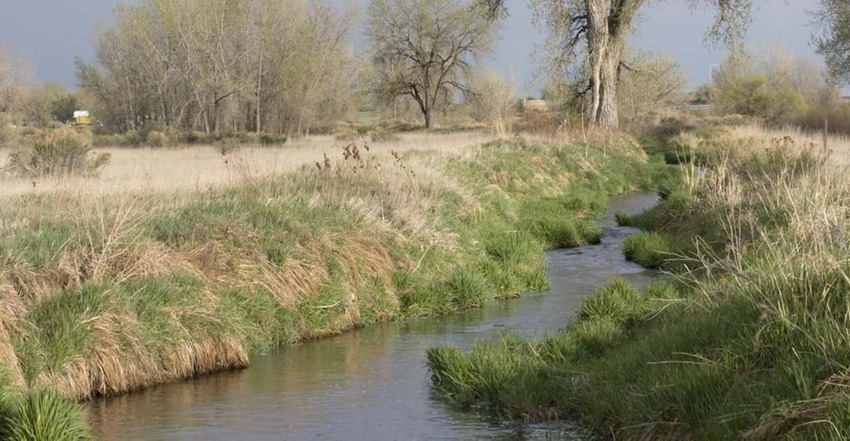
The Environmental Protection Agency is repealing the 2015 Waters of the U.S. rule.
“Today, EPA and the Department of the Army finalized a rule to repeal the previous administration’s overreach in the federal regulation of U.S. waters and recodify the longstanding and familiar regulatory text that previously existed,” said EPA Administrator Andrew Wheeler. “Today’s Step 1 action fulfills a key promise of President Trump and sets the stage for Step 2 – a new WOTUS definition that will provide greater regulatory certainty for farmers, landowners, home builders, and developers nationwide.”
“Before this final rule, a patchwork of regulations existed across the country as a result of various judicial decisions enjoining the 2015 Rule,” said R.D. James, assistant secretary of the Army for Civil Works. “This final rule reestablishes national consistency across the country by returning all jurisdictions to the longstanding regulatory framework that existed prior to the 2015 Rule . . . while the agencies engage in a second rulemaking to revise the definition of ‘waters of the United States.’”
First step
Today’s repeal is the first step in a two-step rulemaking process to define the scope of “waters of the United States” that are regulated under the Clean Water Act. Step 1 provides regulatory certainty as to the definition of “waters of the United States” following years of litigation. In this action, EPA and the Army jointly conclude that multiple substantive and procedural errors warrant a repeal of the 2015 Rule. For example, the 2015 Rule:
Did not implement the legal limits on the scope of the agencies’ authority under the Clean Water Act as intended by Congress and reflected in Supreme Court cases.
Failed to adequately recognize, preserve, and protect the primary responsibilities and rights of states to manage their own land and water resources.
Approached the limits of the agencies’ constitutional and statutory authority absent a clear statement from Congress.
Suffered from certain procedural errors and a lack of adequate record support as it relates to the 2015 Rule’s distance-based limitations.
The final rule takes effect 60 days after publication in the Federal Register.
Step 2
In December 2018, EPA and the Army proposed a new definition that would clearly define where federal jurisdiction begins and ends in accordance with the Clean Water Act and Supreme Court precedent. In the proposal, the agencies provide a clear definition of the difference between federally regulated waterways and those waters that rightfully remain solely under state authority.
Reaction
American Farm Bureau Federation President Zippy Duvall joined the administration for the announcement. He said the WOTUS rule engaged grassroots Farm Bureau members unlike any other issue, with members making tens of thousands of calls on the issue. He said Farm Bureau members welcome the opportunity to develop clear new rules.
“We are relieved to put it behind us,” he said. “We are now working to ensure a fair and reasonable substitute that protects our water and our ability to work and care for the land.”
“President Trump is making good on his promise to reduce burdensome regulations to free our producers to do what they do best – feed, fuel, and clothe this nation and the world,” said Agriculture Secretary Sonny Perdue.
“WOTUS attempted to stretch the reaches of federal power under the Clean Water Act from navigable and interstate waters, which are rightly protected, to encompass ditches, playas, stock ponds, and literally any body of water – regardless of how small or temporary the water may be,” said House Agriculture Committee Ranking Member K. Michael Conaway, R-Texas.
“This administration has gone about this regulatory process the correct way – by listening to stakeholders,” said Sen. Pat Roberts, R-Kansas, chairman of the Senate Ag Committee. “I look forward to reviewing the WOTUS replacement rule within the coming months.”
“After years spent fighting the 2015 WOTUS Rule in the halls of Congress, in the Courts, and at the EPA, cattle producers will sleep a little easier tonight knowing that the nightmare is over,” said National Cattlemen’s Beef Association President Jennifer Houston.
A little history
In January 2018, EPA postponed the applicability date of the WOTUS rule by two years. In June 2017, the EPA and the Corps began a replacement rulemaking process to gather input and re-evaluate the definition of WOTUS. In February 2017, President Trump signed an executive order providing relief from the WOTUS rule.
What others are saying:
Repealing and replacing the WOTUS rule was one of the promises that Donald Trump made during his presidential campaign. With the repeal, the administration has achieved half of his campaign promise. Lawsuits are expected to be filed opposing the rule change. – Bloomberg Environment
Don’t expect any major changes on the ground, since courts have put the 2015 rule on hold in more than half of the states. It’s only in effect in 22 states. – Politico
The new rule reverts standards back to the 1986 guidelines under the Clean Water Act. – CBS News
About the Author(s)
You May Also Like




